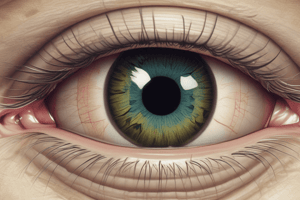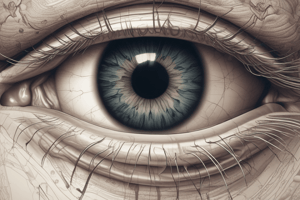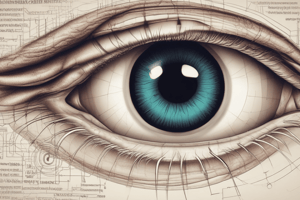Podcast
Questions and Answers
What is the function of a synergist muscle in extraocular motility?
What is the function of a synergist muscle in extraocular motility?
- Acts as an antagonist
- Moves the eye in the opposite direction
- Moves the eye in a random direction
- Helps the agonist to produce a given movement (correct)
Herings' Law of Equal Innervation states that the innervation flow to the agonist and antagonist muscles is always unequal.
Herings' Law of Equal Innervation states that the innervation flow to the agonist and antagonist muscles is always unequal.
False (B)
What is the role of yoke muscles in extraocular motility?
What is the role of yoke muscles in extraocular motility?
To move the eyes in a desired gaze position
During right up gaze, the yoke muscles involved are ___________________ and ___________________.
During right up gaze, the yoke muscles involved are ___________________ and ___________________.
What is the antagonist of RLR during right end gaze?
What is the antagonist of RLR during right end gaze?
What is the law that states that during eye movements, there is an increased flow of innervation to the contracting agonist muscle and a decreased flow of innervation to the relaxing antagonist muscle?
What is the law that states that during eye movements, there is an increased flow of innervation to the contracting agonist muscle and a decreased flow of innervation to the relaxing antagonist muscle?
The primary muscle moving the eye in a given direction is known as the ___________________.
The primary muscle moving the eye in a given direction is known as the ___________________.
Match the following movements with their corresponding yoke muscles:
Match the following movements with their corresponding yoke muscles:
What is the purpose of the NSUCO grading scale in the testing procedure?
What is the purpose of the NSUCO grading scale in the testing procedure?
True or False: Stereoscopic vision requires a small binocular overlap of the visual field.
True or False: Stereoscopic vision requires a small binocular overlap of the visual field.
What is the primary function of pursuit eye movements?
What is the primary function of pursuit eye movements?
Uncrossed disparity occurs when objects are _______________ the object of focus.
Uncrossed disparity occurs when objects are _______________ the object of focus.
Match the following professions with their relevance to stereopsis:
Match the following professions with their relevance to stereopsis:
What is the name of the test used to evaluate saccadic eye movements?
What is the name of the test used to evaluate saccadic eye movements?
True or False: The worth four dot test is used to evaluate stereopsis and fusion.
True or False: The worth four dot test is used to evaluate stereopsis and fusion.
What are the three main requirements for stereoscopic vision?
What are the three main requirements for stereoscopic vision?
What is the muscle combination for right up gaze (Dextroelevation)?
What is the muscle combination for right up gaze (Dextroelevation)?
The H Test is used to detect comitant deviation.
The H Test is used to detect comitant deviation.
What is the purpose of the Motility Test - Broad H Test?
What is the purpose of the Motility Test - Broad H Test?
The ability to maintain a steady fixation on a fixation target is known as ________________.
The ability to maintain a steady fixation on a fixation target is known as ________________.
Match the following eye movements with their descriptions:
Match the following eye movements with their descriptions:
What is the muscle combination for left down gaze (Levodepression)?
What is the muscle combination for left down gaze (Levodepression)?
During the H Test, the subject is instructed to move their head.
During the H Test, the subject is instructed to move their head.
What is the symptom of skipping words when reading?
What is the symptom of skipping words when reading?
Which cranial nerve controls the Superior Oblique (SO) muscle?
Which cranial nerve controls the Superior Oblique (SO) muscle?
Ductions are binocular eye movements.
Ductions are binocular eye movements.
What is the primary position of gaze?
What is the primary position of gaze?
The _______________ type of eye movement is where both eyes move in opposite directions.
The _______________ type of eye movement is where both eyes move in opposite directions.
Which type of version is when the gaze moves towards the right?
Which type of version is when the gaze moves towards the right?
Match the following types of eye movements with their descriptions:
Match the following types of eye movements with their descriptions:
Convergence is when both eyes move away from the midline.
Convergence is when both eyes move away from the midline.
What is the purpose of testing ductions?
What is the purpose of testing ductions?
What is the formula to calculate vergence demand?
What is the formula to calculate vergence demand?
Tonic vergence can be measured directly.
Tonic vergence can be measured directly.
What is the normal range of AC/A ratio?
What is the normal range of AC/A ratio?
The movement of both eyes in the same direction is known as ________ movements.
The movement of both eyes in the same direction is known as ________ movements.
What is accommodative convergence?
What is accommodative convergence?
Match the type of vergence with its description:
Match the type of vergence with its description:
Supra vergence is a type of convergent movement.
Supra vergence is a type of convergent movement.
What is the unit of measurement of vergence demand?
What is the unit of measurement of vergence demand?
What is the purpose of the Fusional Vergence Amplitude test?
What is the purpose of the Fusional Vergence Amplitude test?
What type of prisms are not used in the Fusional Vergence Amplitude test?
What type of prisms are not used in the Fusional Vergence Amplitude test?
What is the purpose of the fixation target in the Fusional Vergence Amplitude test?
What is the purpose of the fixation target in the Fusional Vergence Amplitude test?
What is the unit of measurement of the results of the Fusional Vergence Amplitude test?
What is the unit of measurement of the results of the Fusional Vergence Amplitude test?
What is the term for the point at which the patient's eyes can no longer fuse and single vision is broken?
What is the term for the point at which the patient's eyes can no longer fuse and single vision is broken?
What is the primary position of gaze?
What is the primary position of gaze?
What is the difference between heterophoria and heterotropia?
What is the difference between heterophoria and heterotropia?
What is the term for the point at which the patient's eyes regain fusion after breaking?
What is the term for the point at which the patient's eyes regain fusion after breaking?
What is the purpose of measuring the NFV and PFV values in the Fusional Vergence Amplitude test?
What is the purpose of measuring the NFV and PFV values in the Fusional Vergence Amplitude test?
What is orthophoria?
What is orthophoria?
What is the Cover Test used for?
What is the Cover Test used for?
What is the typical distance used for far fixation in the Fusional Vergence Amplitude test?
What is the typical distance used for far fixation in the Fusional Vergence Amplitude test?
What is the main difference between monocular and binocular conditions?
What is the main difference between monocular and binocular conditions?
What is the prevalence of exophoria?
What is the prevalence of exophoria?
What is the main characteristic of intermittent deviation?
What is the main characteristic of intermittent deviation?
What is the main difference between phoria and tropia?
What is the main difference between phoria and tropia?
What is the minimum FV reserve blur required for asymptomatic exophoria according to Sheard's criteria?
What is the minimum FV reserve blur required for asymptomatic exophoria according to Sheard's criteria?
What is the purpose of prescribing prisms based on fixation disparity?
What is the purpose of prescribing prisms based on fixation disparity?
What is the primary function of the NSUCO grading scale?
What is the primary function of the NSUCO grading scale?
A patient has a NFV of 3 BI and a PFV of 15 BO. What is the prism required to decrease PFV to 12 pd and increase NFV to 6 pd?
A patient has a NFV of 3 BI and a PFV of 15 BO. What is the prism required to decrease PFV to 12 pd and increase NFV to 6 pd?
Which criterion is a good discriminator for exo deviations?
Which criterion is a good discriminator for exo deviations?
A patient has a near phoria of 10 XP and a PFV blur of 20 pd. How many prisms of base-in prism are required?
A patient has a near phoria of 10 XP and a PFV blur of 20 pd. How many prisms of base-in prism are required?
What is the midpoint of phoria position required for non-symptomatic esophoria according to Percival's criteria?
What is the midpoint of phoria position required for non-symptomatic esophoria according to Percival's criteria?
What is the requirement for stereoscopic vision?
What is the requirement for stereoscopic vision?
What is the primary purpose of the Motility Test - Broad H Test?
What is the primary purpose of the Motility Test - Broad H Test?
What is the type of disparity that occurs when objects are behind the object of focus?
What is the type of disparity that occurs when objects are behind the object of focus?
What is the muscle combination for right down gaze (Dextrodepression)?
What is the muscle combination for right down gaze (Dextrodepression)?
Which profession requires stereoscopic vision?
Which profession requires stereoscopic vision?
What is the symptom of reading the same line or letters twice or skipping a line?
What is the symptom of reading the same line or letters twice or skipping a line?
What is the purpose of the Worth four dot test?
What is the purpose of the Worth four dot test?
What is the type of eye movement that is conjugate?
What is the type of eye movement that is conjugate?
What is the testing procedure for pursuits?
What is the testing procedure for pursuits?
What is the law that states that during eye movements, there is an increased flow of innervation to the contracting agonist muscle and a decreased flow of innervation to the relaxing antagonist muscle?
What is the law that states that during eye movements, there is an increased flow of innervation to the contracting agonist muscle and a decreased flow of innervation to the relaxing antagonist muscle?
What is the primary function of fixation?
What is the primary function of fixation?
What is the rating scale used for saccades and pursuits?
What is the rating scale used for saccades and pursuits?
What is the purpose of testing saccadic eye movements?
What is the purpose of testing saccadic eye movements?
What is the muscle combination for convergence?
What is the muscle combination for convergence?
What is the purpose of the procedure in the Motility Test - Broad H Test?
What is the purpose of the procedure in the Motility Test - Broad H Test?
What is the symptom of excessive head movement while reading?
What is the symptom of excessive head movement while reading?
What is the type of eye movement that is where both eyes move in opposite directions?
What is the type of eye movement that is where both eyes move in opposite directions?
Flashcards are hidden until you start studying
Study Notes
Extraocular Motility
- Six muscles control extraocular movements: 4 recti and 2 obliques
- Control by cranial nerves: Oculomotor (CN III), Trochlear (CN IV), and Abducens (CN VI)
- Types of eye movements: Ductions, Versions, and Vergence
Ductions
- Monocular eye movements
- Tested monocularly by covering one eye
- Six types of ductions:
- Horizontal direction: Abduction (eye moves away from midline) and Adduction (eye moves towards midline)
- Vertical direction: Supraduction (eye moves upwards) and Infraduction (eye moves downwards)
- Cycloversion: Incycloduction (rotation of upper cornea towards midline) and Excycloduction (rotation of upper cornea away from midline)
Versions
- Binocular eye movements
- Tested binocularly by covering one eye
- Six types of versions:
- Horizontal direction: Dextroversion (gaze moves towards the right) and Levoversion (gaze moves towards the left)
- Vertical direction: Supraversion (gaze moves upwards) and Infraversion (gaze moves downwards)
- Cycloversion: Dextrocycloversion (both upper corneas rotate towards the right) and Levocycloversion (both upper corneas rotate towards the left)
Vergence
- Eye movements in opposite directions
- Types of vergence:
- Convergence: both eyes move towards the midline
- Divergence: both eyes move away from the midline
- Supra vergence: one eye moves upwards and the other eye straight
- Infra vergence: one eye moves downwards and the other eye straight
Vergence Tests
- Stereopsis: Appreciation of relative depth due to retinal disparity
- Three main requirements for stereoscopic vision:
- Large binocular overlap of the visual field
- Partial decussation of the afferent visual fibers
- Coordinated conjugate eye movements
- Critical professions requiring stereopsis: Pilots, Policemen, Railways, Drivers, Sports, Binocular Microscopes, Surgeons, Dentist, Optometrist, Microbiologist, and Virtual Reality
Laws of Extraocular Motility
- Herings' Law of Equal Innervation: equal and simultaneous innervation flows to yoke muscles
- Sherrington's Law of Reciprocal Innervation: increased flow of innervation to contracting agonist muscle and decreased flow of innervation to relaxing antagonist muscle
Eye Movements and Muscles
- Yoke muscles in both eyes:
- Right gaze (Dextroversion): RLR & LMR
- Right up gaze (Dextroelevation): RSR & LIO
- Right down gaze (Dextrodepression): RIR & LSO
- Left gaze (Levoversion): LLR & RMR
- Left up gaze (Levoelevation): LSR & RIO
- Left down gaze (Levodepression): LIR & RSO
Motility Test - Broad H Test
- Purpose:
- Restriction of eye movements in different gaze positions
- Detects non-comitant deviation (deviation is different at different gaze positions)
- Pain/discomfort during eye movements
- Procedure:
- Use pen/pen torch
- Move in a H pattern
- Hold target at comfortable working distance
- Instruct the subject to follow the target, not to move their head
- Record:
- SAFE (Smooth, Accurate, full and Extensive)
- Full, free, painless
- Compare palpebral aperture size/scleral show
- Ask for:
- Diplopia (subjective), at any gaze
- Pain or discomfort (subjective), at any gaze
Fixations, Saccades & Pursuits
- Fixation:
- Ability to maintain a steady fixation on a fixation target
- Symptoms:
- Loses place when reading
- Skips words when reading
- Reads same line/letters twice or skips a line
- Excessive head movement while reading
- Poor ability to copy from whiteboard
- Misaligns columns of numbers
- Repeats letters within words
- Procedure:
- Observation of fixation for 10 sec
- Target used: accommodative target- pen, picture
- Look for stability or refixations
- Saccade:
- Redirect the eyes fixation from one target to another
- Conjugate eye movement, e.g., reading
- Testing Procedure:
- Harmon distance or at 30-40 cm
- Two targets at 10cm apart from midline
- NSUCO grading
- Recommended test: NSUCO Grading scale
- Rate the performance in 4 categories:
- Ability
- Accuracy
- Head movements
- Body movements
- Rate the performance in 4 categories:
- Pursuits:
- Test the ability of following eye movements
- Helps to track a moving object in the environment, e.g., follow a tennis ball
- Testing Procedure:
- Working distance 30-40cm
- One target – move in a circle of 20cm diameter
- Two clockwise and two anticlockwise directions
- Test performed in standing position to look for body movements
- Recommended test: NSUCO grading scale
- Rate the performance in 4 categories:
- Ability
- Accuracy
- Head movements
- Body movements
- Rate the performance in 4 categories:
Studying That Suits You
Use AI to generate personalized quizzes and flashcards to suit your learning preferences.




